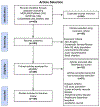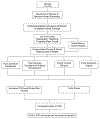Disparities in peripheral artery disease care: A review and call for action
- PMID: 35672104
- PMCID: PMC9254894
- DOI: 10.1053/j.semvascsurg.2022.05.003
Disparities in peripheral artery disease care: A review and call for action
Abstract
Peripheral artery disease (PAD), the pathophysiologic narrowing of arterial blood vessels of the lower leg due to atherosclerosis, is a highly prevalent disease that affects more than 6 million individuals 40 years and older in the United States, with sharp increases in prevalence with age. Morbidity and mortality rates in patients with PAD range from 30% to 70% during the 5- to 15-year period after diagnosis and PAD is associated with poor health outcomes and reduced functionality and quality of life. Despite advances in medical, endovascular, and open surgical techniques, there is striking variation in care among population subgroups defined by sex, race and ethnicity, and socioeconomic status, with concomitant differences in preoperative medication optimization, amputation risk, and overall health outcomes. We reviewed studies from 1995 to 2021 to provide a comprehensive analysis of the current impact of disparities on the treatment and management of PAD and offer action items that require strategic partnership with primary care providers, researchers, patients, and their communities. With new technologies and collaborative approaches, optimal management across all population subgroups is possible.
Copyright © 2022 The Author(s). Published by Elsevier Inc. All rights reserved.
Figures



Similar articles
-
Racial disparities in outcomes of endovascular procedures for peripheral arterial disease: an evaluation of California hospitals, 2005-2009.Ann Vasc Surg. 2015 Jul;29(5):950-9. doi: 10.1016/j.avsg.2015.01.006. Epub 2015 Mar 7. Ann Vasc Surg. 2015. PMID: 25757991 Free PMC article.
-
Regional variation in racial disparities among patients with peripheral artery disease.J Vasc Surg. 2018 Aug;68(2):519-526. doi: 10.1016/j.jvs.2017.10.090. Epub 2018 Feb 16. J Vasc Surg. 2018. PMID: 29459014 Free PMC article.
-
Lower Extremity Peripheral Artery Disease: Contemporary Epidemiology, Management Gaps, and Future Directions: A Scientific Statement From the American Heart Association.Circulation. 2021 Aug 31;144(9):e171-e191. doi: 10.1161/CIR.0000000000001005. Epub 2021 Jul 28. Circulation. 2021. PMID: 34315230 Free PMC article. Review.
-
Disparities in Diagnosis, Treatment, and Outcomes of Peripheral Artery Disease: JACC Scientific Statement.J Am Coll Cardiol. 2023 Dec 12;82(24):2312-2328. doi: 10.1016/j.jacc.2023.09.830. J Am Coll Cardiol. 2023. PMID: 38057074 Review.
-
Racial, ethnic, and socioeconomic inequities in amputation risk for patients with peripheral artery disease and diabetes.Semin Vasc Surg. 2023 Mar;36(1):9-18. doi: 10.1053/j.semvascsurg.2023.01.005. Epub 2023 Feb 2. Semin Vasc Surg. 2023. PMID: 36958903 Review.
Cited by
-
2024 TSOC/TSPS Joint Consensus: Strategies for Advanced Vascular Wound Management in Arterial and Venous Diseases.Acta Cardiol Sin. 2024 Jan;40(1):1-44. doi: 10.6515/ACS.202401_40(1).20231220A. Acta Cardiol Sin. 2024. PMID: 38264067 Free PMC article.
-
Clinical and Cardiovascular Profile in Patients With Peripheral Artery Disease.Cureus. 2023 May 28;15(5):e39586. doi: 10.7759/cureus.39586. eCollection 2023 May. Cureus. 2023. PMID: 37384087 Free PMC article.
-
Practice patterns of peripheral vascular interventions for peripheral artery disease in the office-based laboratory setting versus outpatient hospital.J Vasc Surg. 2024 Nov;80(5):1525-1536.e7. doi: 10.1016/j.jvs.2024.06.006. Epub 2024 Jun 20. J Vasc Surg. 2024. PMID: 38908807
-
Impact of neighborhood social disadvantage on the presentation and management of peripheral artery disease.J Vasc Surg. 2023 May;77(5):1477-1485. doi: 10.1016/j.jvs.2022.12.062. Epub 2023 Jan 7. J Vasc Surg. 2023. PMID: 36626955 Free PMC article.
-
Global burden of peripheral arterial disease and its risk factors, 1990-2021.BMC Cardiovasc Disord. 2025 Aug 26;25(1):631. doi: 10.1186/s12872-025-05055-2. BMC Cardiovasc Disord. 2025. PMID: 40859165 Free PMC article.
References
-
- Allison MA, Ho E, Denenberg JO, et al. Ethnic-specific prevalence of peripheral arterial disease in the united states. Am J Prev Med 2007;32:328–33. - PubMed
-
- Hirsch AT, Haskal ZJ, Hertzer NR, et al. ACC/AHA 2005 guidelines for the management of patients with peripheral arterial disease (lower extremity, renal, mesenteric, and abdominal aortic): executive summary a collaborative report from the American Association for Vascular Surgery/Society for Vascular Surgery, Society for Cardiovascular Angiography and Interventions, Society for Vascular Medicine and Biology, Society of Interventional Radiology, and the ACC/AHA Task Force on Practice Guidelines Writing Committee to Develop Guidelines for the Management of Patients With Peripheral Arterial Disease) endorsed by the American Association of Cardiovascular and Pulmonary Rehabilitation; National Heart, Lung, and Blood Institute; Society for Vascular Nursing; TransAtlantic Inter-Society Consensus; and Vascular Disease Foundation. J Am Coll Cardiol 2006;47:1239–312. - PubMed
-
- Diehm C, Schuster A, Allenberg JR, et al. High prevalence of peripheral arterial disease and co-morbidity in 6880 primary care patients: cross-sectional study. Atherosclerosis 2004;172:95–105. - PubMed
-
- Moussa ID, Jaff MR, Mehran R, et al. Prevalence and prediction of previously unrecognized peripheral arterial disease in patients with coronary artery disease: the Peripheral Arterial Disease in Interventional Patients Study. Catheter Cardiovasc Interv 2009;73:719–24. - PubMed
-
- Hirsch AT, Allison MA, Gomes AS, et al. A call to action: women and peripheral artery disease: a scientific statement from the American Heart Association. Circulation 2012;125:1449–72. - PubMed
Publication types
MeSH terms
Grants and funding
LinkOut - more resources
Full Text Sources
Medical
Miscellaneous

